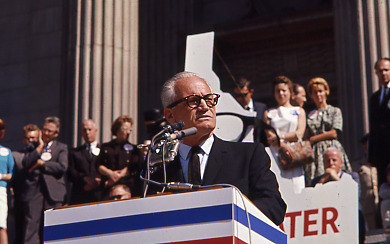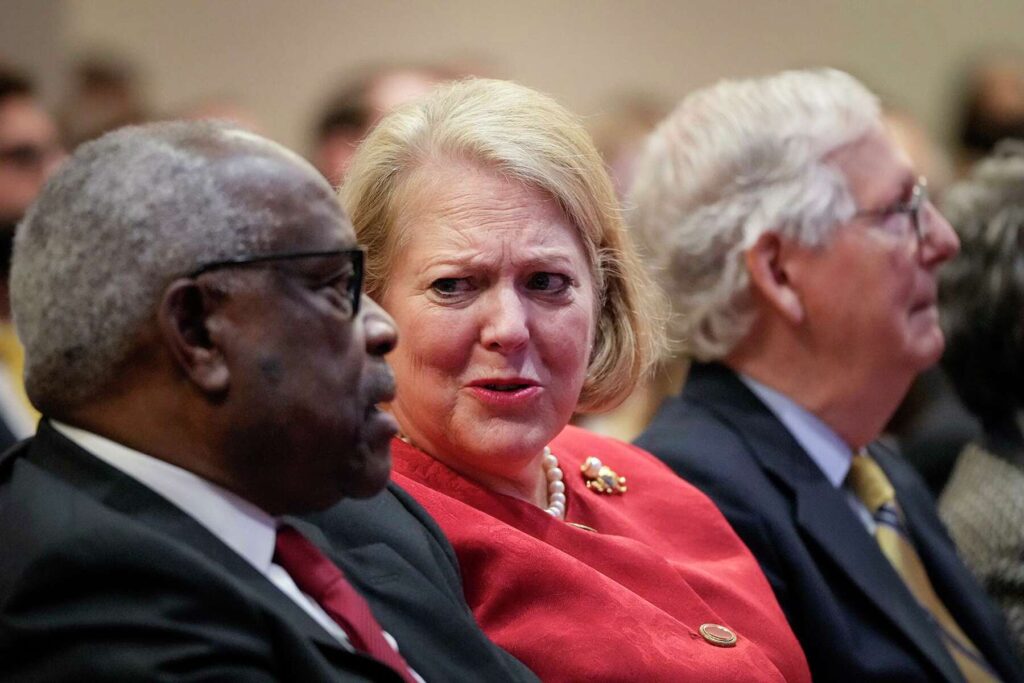The Idaho Republican Party is divided, deeply divided. The incumbent governor faces a serious primary challenge from the far right. The challenger is a favorite of what was once considered the party’s “fringe,” and benefits from a grassroots movement to take the party back from its more moderate wing.
The governor can – and almost constantly does – boast of a booming economy that he contends happened only because of his careful management of the state budget.
The challenger counters that the incumbent is not a true conservative and is out of touch with the party, claiming “If I am elected, the office of governor will become a place where the governor listens.”
The governor recently signed controversial legislation that has drawn condemnation from many quarters. The legislation has been challenged in court and will certainly be an issue in the coming election.
The Republican Party’s ideological battle lines are further defined by the role of the party’s last presidential candidate, a charismatic and deeply controversial figure who some worship, cult-like, as a political savior and others condemn as a threat to American democracy.
Overall voters are in a sour mood. The economy is strong, but inflation is problematic. The Democratic president is unpopular. Federal spending is a concern and Washington is consumed by a little understood war in a far-off place. The conflict has international implications that threaten to pull the country ever deeper into the conflict. In many ways it’s a difficult time to be an incumbent.
Idaho in 2022? Yes.
But also, Idaho in 1966, the last time an incumbent Republican governor was seriously challenged within this own party.
Today the names are Brad Little, Janice McGeachin and Donald Trump. Fifty-six years ago, the names were Bob Smylie, Don Samuelson and Barry Goldwater. The parallels between the two elections are, frankly, a bit eerie.

History does not repeat, at least not precisely. But, if history were to repeat, incumbent Governor Brad Little would be losing sleep, as his predecessor Bob Smylie did toward the end of his 1966 Republican primary.
Smylie, a three-term incumbent and a moderate, was coming off two major accomplishments: he had engineered passage of the first ever Idaho sales tax and in the wake of a Supreme Court mandate had championed a sweeping reapportionment of the state legislature. Both remain part of Smylie’s very impressive legacy during his 12 years as governor, and each also contributed something to his downfall.
Samuelson, a Sandpoint state senator and darling of the far right, was a little-known legislative backbencher when he announced, at the urging of some of the party’s most fervent Barry Goldwater supporters, that he was going after the governor of his own party. Hardly anyone gave Samuelson, a big, backslapping politician with a flattop haircut, any chance. Many ridiculed his less than polished speaking style. He had no legislative record to run on short of opposing Smylie’s sales tax measure. Still, he had what often counts for a lot in politics. Samuelson was in the right place at the right time.

Much like Brad Little now, Smylie barely acknowledged in 1966 that he had an opponent. He touted the economy on his watch and pretended to be above the bitter controversy roiling the Republican Party. A good deal of that controversy related to Goldwater’s candidacy in 1964, when the very conservative Arizona senator lost the presidency in a landslide, but arguably became the most consequential loser in American political history. As William F. Buckley famously quipped: Goldwater lost the presidency to Lyndon Johnson but won it for Ronald Reagan in 1980 when the most conservative wing of the GOP established itself as the dominant force in Republican politics.
The fight raging in Idaho now will help determine if the party goes even farther right and embraces the most militant elements of the right, the foot soldiers and Trumpy loyalists who power Janice McGeachin’s insurgent campaign. In words that fit today’s circumstances one Democratic Party leader called the 1966 Republican race: “a melodrama complete with confusion and terror.” Maybe history does repeat.
Smylie realized too late that basically ignoring Samuelson’s challenge was a mistake. The two men got into a squabble over whether Goldwater had effectively endorsed the incumbent – Goldwater said he hasn’t – which made Smylie look a bit desperate. By late July – Idaho primaries were held in August at the time – Smylie, the polished political pro, was playing defense with Samuelson attacking him on the oldest issue in the Idaho political playbook: water. Smylie had complete control of the state water resource board, Samuelson charged, and was constantly overriding the board’s “wise and important” decisions. The implication was clear. Smylie wasn’t protecting Idaho’s water. (Paging Mike Simpson.)
The other millstone around Smylie’s neck was that old and fatal political disease: the voters were sick of him and ready for change. Combine the substantial and frequently warranted criticism Little has received for his lack of management of Covid-19 with the reality that he has been, as lieutenant governor and governor, at the top of Idaho’s political ladder for 14 straight years, his sell by date could be a factor next month.
Don Samuelson, the guy very few took seriously as a challenger to an entrenched incumbent, absolutely crushed Bob Smylie in the Republican gubernatorial primary in 1966, winning more than 61% of the vote. He went on to win a close contest in November that featured an up-and-coming young Democrat from Orofino by name of Cecil Andrus, as well as controversial third-party candidates – another parallel with 2022, perhaps.
Four years later, Andrus came back and defeated Samuelson who had been a barely competent chief executive. That election ushered in 24 consecutive years of Democratic control of the governor’s office. Here’s where the parallels break down – maybe.
McGeachin is a profoundly flawed candidate who has demonstrated she can’t manage the low six figure budget of her own office let alone the state’s billion-dollar finances. She’s also advanced wacky positions on education and public health, any of which ought to be disqualifying. Yet she has the Trump’s endorsement. And as for wacky positions, if those were disqualifying a lot of Republicans would be looking for work.
Little, a lackluster campaigner, is sitting on a lead hoping to run out the clock, never a smart political play. A month out from the May primary he must be considered the heavy favorite, if only because a lot of Idahoans see him as a safer choice than a candidate who associates regularly with white supremacists and militia radicals. Little is, in other words, the lesser of evils, a McGeachin lite in blue jeans with many of the same policies packaged more presentably. It’s probably enough to get him across the finish line.
Then again lots of people said the same about Bob Smylie.
—–0—–
Additional Readings:
A few more things I hope you will find of interest …
The guy who brought us CRT panic offers a new far-right agenda: Destroy public education
Hard to believe, but believe it – some on the far right, well-funded and passionate, are out to destroy public education.
“The man in question is Christopher Rufo, a senior fellow at the Manhattan Institute, a conservative think tank. Since he helped elevate CRT into a national culture war in 2020, Rufo has frequently been cast (or cast himself) as the new master strategist of the right, playing three-dimensional chess as he lays out his battle plans publicly and counts every media mention of them as a win. In the spring of 2021, he famously crowed on social media that he’d ‘successfully frozen’ the CRT ‘brand’ as the overarching ideology behind almost everything conservatives dislike. This January he tweeted about his new goal to ‘bait the Left into opposing [curriculum] ‘transparency,’ in order to trigger conservative suspicions that public schools have something to hide.”
Be worried. These jokers are serious.
Ginni Thomas Is Not A Liar
Politico has a provocative look at the ideology – and belief system – of the wife of the most prominent Supreme Court justice.

“[Ginni] Thomas’ fervid text messages to then-Trump White House Chief of Staff Mark Meadows and others, urging vigorous efforts to halt Biden’s ascension to the presidency and keep the incumbent in place, have some evidentiary value to the House’s select Jan. 6 committee as it develops a chronology of events leading to the deadly mayhem on Capitol Hill.
“The Thomas texts, however, are far more revelatory as psychological disclosures — a breathtaking window into the mind of a Trump believer. In that sense, there are three distinct ways in which the Thomas texts illuminate the broader historical moment.”
In the Judiciary Wars, Republicans Like Lindsey Graham Play Dirtier Than Democrats
Speaking of the judicial branch. From Bill Scher in The Washington Monthly.
“Politics ain’t beanbag, and that’s doubly true for judicial politics. But let’s have a clear-eyed assessment of how both parties have waged battle.
“Democrats have been more selective in their targets, aiming to block far-right ideologues and set high standards regarding past sexual misconduct. Such an objective does require harsh treatment of individuals. Republicans have sought to deny Democrats the ability to fill seats with anyone.”
The Notorious Legends and Dubious Stories of 10 Literary Deaths
Emily Temple on how some writers left us, like say Evelyn Waugh.
“His body was found in the bathroom, by some accounts with a gash on his forehead and water in his lungs.”
Thanks for reading. Stay in touch.
